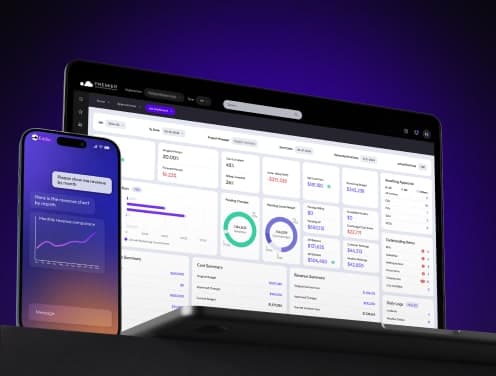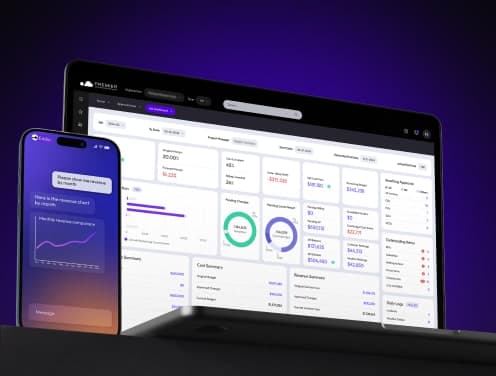
CMIC vs Acumatica Cloud ERP: Real Cost & Features Compared
Picking the right construction management software is crucial. CMIC vs Acumatica stands out as a top comparison for project managers and CFOs. The construction accounting software market reached $497.34 million in 2021. Experts predict it will grow to $978.65 million by 2027. This makes your software choice more important than ever.
Acumatica Cloud ERP and CMiC take different paths to construction business management. Acumatica brings a flexible platform with an easy-to-use interface that adapts to business growth. Users rate it highly at 4.7/5. CMiC specializes in construction and engineering with complete project management features. It receives a 3.9/5 rating.
These systems provide cloud-based business management solutions for different needs. Acumatica Cloud ERP suits small and mid-sized organizations in finance, manufacturing, and construction. CMiC targets general contractors, specialty contractors, and project owners in the Architecture, Engineering, and Construction (AEC) industry.
Construction accounting software provides better project control, secure record keeping, and improved estimates. The market grows as the construction industry expands and more companies adopt ERP software for their projects.
This piece compares CMiC and Acumatica's costs and features. It helps you pick the right platform for your construction business needs. You'll also learn how these options compare to new alternatives in today's fast-changing construction tech world.
Platform Overview: CMiC vs Acumatica vs Premier
The right ERP platform choice depends on understanding each system's core architecture, target market, and strengths. Here's how these three construction management solutions compare.
CMiC: Construction-focused ERP with legacy roots
CMiC is a specialized ERP system built for construction and capital project firms. The system uses a Single Database Platform that connects financial and operational processes. This unified design helps companies avoid scattered data across their project management tasks.
Customer reviews give CMiC 4.2 out of 5 stars based on 158 reviews. Users value its detailed construction-specific features. The system's reach is significant - it serves 25% of ENR's top 400 contractors and handles about $100 billion in construction revenue each year.
Two main product pillars make up CMiC's offerings: CMiC Financials and CMiC Project Management. Financial modules cover construction accounting, human capital management, payroll, equipment tracking, and inventory control. Project management features support bidding, procurement, document management, quality control, and safety protocols.
CMiC gives clients cloud and on-premise deployment options. This traditional foundation sometimes shows in its user experience, with a 3.9/5 ease-of-use rating that falls behind competitors.
Acumatica: Cloud-native ERP for growing businesses
Acumatica started as a cloud-based solution, which shows in its modern user experience. Users rate it 4.3 out of 5 stars from 157 reviews. The platform scores 8.3/10 for ease of use, well ahead of CMiC's 6.1/10.
Mid-market companies looking to grow will find Acumatica particularly appealing. The platform offers:
- Flexible deployment options (public or private cloud)
- Consumption-based licensing that grows with you
- No-code customization tools for business users
- Cross-module workflows that enhance collaboration
Acumatica focuses on customer needs rather than shareholder demands. This strategy has made it the fastest-growing Cloud ERP company for ten straight years, according to company data.
The construction edition supports general contractors, trade contractors, and service contractors. Users get job cost accounting, project management, inventory control, and detailed cost projections - key features for construction operations.
Premier: Modern ERP built for construction from the ground up
Premier Construction Software brings a fresh approach to cloud-based construction ERP solutions. Teams, financials, and projects come together in one environment to boost operational excellence.
Premier may be newer than CMiC and Acumatica, but it stands out with AI-powered features. The system spots project red flags, finds critical details, customizes tasks, and streamlines workflows using predictive intelligence.
Construction-specific financial management is Premier's strong suit. The platform handles P&L statements, cash flow reporting, balance sheets, and WIP tracking effectively. Teams can track labor, materials, and overhead expenses with great accuracy through its job costing features.
Users love Premier's customer support, rating it 4.8/5. A 2025 construction accounting software guide named it the best value for money. Premier offers an appealing mix of modern features and AI capabilities that compete well with CMiC's legacy strength and Acumatica's cloud flexibility.
Deployment Models and Accessibility
The way construction teams work each day depends heavily on whether they choose cloud or on-premise deployment models. CMIC and Acumatica each take different approaches to these basic infrastructure decisions. Their choices affect everything from how teams access the system to what it costs.
Cloud vs On-Premise: Flexibility and limitations
Construction companies now prefer cloud-based systems because they're easier to set up and maintain. CMiC's cloud option helps organizations avoid spending money on expensive hardware or hiring dedicated IT staff. Acumatica's SaaS deployment runs on AWS hosting, which takes care of maintenance, updates, and security automatically.
Some scenarios still make on-premise solutions attractive. CMiC's on-premise option lets organizations control their hardware, software, and security setup. This control is vital for construction firms that handle sensitive information or must meet strict regulations.
Key differences worth noting:
- Internet Dependency: On-premise systems work without internet access, which means no downtime during outages. Cloud solutions need reliable internet to work.
- Scalability: Cloud systems let you scale up or down without changing hardware. Acumatica offers consumption-based pricing that doesn't charge extra when you add users.
- Security Considerations: On-premise solutions give you direct control over security. Cloud providers usually offer enterprise-level security that many companies couldn't afford on their own.
A 2023 McKinsey study showed that fewer than 10% of organizations moved their critical business systems to the cloud. Companies hesitate because they worry about 24/7 availability and following regulations.
Mobile Access: Field usability across platforms
Mobile access makes a big difference when comparing CMIC and Acumatica. Both platforms know construction teams need to access important information in the field.
CMiC's mobile apps bring office data to the job site. Their apps work on iOS and Android devices, which helps more people use them. Teams can keep working even without internet thanks to offline features.
Acumatica makes its system easy to use on any device. They offer web access plus iPhone and Android apps. Their platform helps remote employees, partners, and clients work together in real time.
The user interface design affects how quickly people start using the system. CMiC knows that complicated interfaces can slow down adoption and make the system less effective. Users say Acumatica does a better job with customization options.
Premier's cloud-first approach for remote teams
Premier Construction Software takes a different path as a pure cloud-based ERP solution on Microsoft Azure. Teams don't need expensive servers or IT maintenance. The system updates automatically and includes strong security.
Remote teams get several benefits from Premier:
- Anytime, anywhere access: Team members connect from any device - in the field, office, or home.
- Real-time collaboration: Premier puts all project data in one place. This helps distributed teams see and share information better.
- Guest access capabilities: Architects, clients, and subcontractors can work together through special portals.
Users love Premier's cloud access. Every review that mentions this feature rates it well. The simple job dashboard helps teams track projects through their whole lifecycle. This works great for teams spread across different locations.
Premier's cloud-first approach matches how construction work is changing. Many construction companies now want to move from old systems to cloud solutions. Premier gives modern teams the flexibility, growth potential, and remote collaboration they need while keeping all the construction-specific features.
Core Features Compared
Feature comparisons help you gain valuable insights when choosing construction ERP systems. The right features can make a big difference in project timelines, budget accuracy, and team coordination throughout construction phases.
Project Management: CMiC vs Acumatica vs Premier
Project management features are the foundations of any construction software solution. CMiC's project management module excels with quality and safety management features that track projects until final closeout. The platform brings together project-related communications and documents that connect job sites with back-office operations.
Acumatica provides complete project management tools for construction teams. These tools are part of a broader ERP system rather than having construction-specific origins. Their system has scheduling, resource allocation, and cost tracking features that support construction projects.
Premier Construction Software takes a step further with AI-powered features that detect potential issues early. The platform uses predictive project forecasting to spot budget concerns or schedule delays, giving managers enough time to take corrective action.
Financial Modules: Billing, Payroll, and Job Costing
Each platform handles financial management differently. CMiC has strong accounting management that brings together accounts payable, receivable, and general ledger in one platform. Its job costing feature, vital for construction, tracks all project costs from labor and materials to overhead.
Acumatica has strong financial management tools with job cost accounting built for construction companies. The system focuses on immediate financial tracking and reporting. Users note that support quality (rated 8.0) lags behind Premier's 9.3 rating.
Premier shines in financial management with complete tools for P&L statements, cash flow reporting, balance sheets, and WIP tracking. Its automated budget management spots differences between planned and actual spending quickly, which reduces errors.
Document Management and Collaboration Tools
Document handling plays a key role in platform selection. CMiC's Drawing & Construction Documents application serves as a central hub for all project documentation. Teams can view, mark up, and share construction drawings, ensuring everyone works from the latest approved documents.
Key features include:
- Metadata extraction and hyperlink insertion for easy navigation
- Drawing and specification collaboration tools
- Annotation capabilities linked to RFIs and issues
Acumatica works with DocLink, a document management solution that speeds up processes. It captures documents, routes them through approval workflows, and takes needed actions. This integration helps companies move away from paper-based processes.
Premier's document management system focuses on real-time collaboration through cloud technology. The platform brings project data together to improve visibility for distributed teams.
AI and Automation: Premier's edge in smart workflows
Premier stands out through advanced AI integration in its ERP system. AI-powered automation improves workflow efficiency by cutting down manual data entry and errors. Machine learning provides quick insights to optimize inventory and production schedules for better customer satisfaction.
The results are clear, AI-powered automation can cut document processing time from 30 minutes to 5 minutes. Companies using AI in their ERP systems see a 40% productivity increase, mainly in financial tasks.
Construction firms with tight schedules benefit from Premier's AI features:
- Predictive forecasting spots potential budget issues early
- Automated routing speeds up invoice and change order approvals
- Immediate risk management detects issues like delayed invoices
While CMiC and Acumatica offer automation features, they haven't embraced AI as fully as Premier. The global market for AI in construction will grow from $1.80 billion in 2023 to $12.10 billion by 2030, putting Premier ahead of this trend.
In a nutshell, all three platforms have complete features, but Premier's AI capabilities and construction-specific design give it clear advantages in efficiency, accuracy, and future-ready functionality.
Ease of Use and User Experience
User interface can make or break adoption rates for construction ERP systems. The difference between clunky, complicated software and easy-to-use platforms affects field productivity and ROI directly.
Interface Design: Legacy vs Modern UI
CMiC's interface shows its historical roots. Some users noted it was "DOS based" in earlier versions. This legacy foundation creates challenges for new users who expect modern, efficient experiences. Teams take extensive time to become proficient with the system's complexity.
Acumatica provides a more contemporary interface with better customization options. Users rate Acumatica's ease-of-use at 4.1/5 compared to CMiC's 3.9/5. This gap in user experience becomes crucial for construction teams who just need quick access to information under demanding field conditions.
Key interface differences between platforms:
- Clean vs. complex layouts - Acumatica has logical navigation and well-laid-out menus that help users quickly learn where to click
- Customization flexibility - Acumatica offers better customization capabilities, so teams can adapt screens to match specific workflow needs
- Visual clarity - Modern interfaces like Premier's use high-contrast elements that stay visible even in bright outdoor conditions
Learning Curve and Onboarding
Construction ERP systems have vastly different learning curves. One user said about a complex ERP: "The system is so large and powerful that learning the controls and backend can take years". Lost productivity and frustration result from this extended time-to-proficiency.
Detailed training programs are crucial for successful implementation. Well-designed ERP training helps teams understand standard procedures, follow policies, and employ tools effectively. The interface's ease of use determines training effectiveness. Systems with clear, logical workflows can cut training time by up to 80%.
Premier Construction Software makes onboarding faster through user-focused design principles. Their approach aligns with the growing recognition that user experience substantially affects adoption rates. Users explore systems more willingly when they feel familiar and approachable.
Mobile Usability in the Field
Construction teams just need mobile interfaces suited to field conditions. Critical mobile usability factors include:
Offline access capabilities let work continue during connectivity disruptions. Voice commands and expanded touch targets work with protective gloves that affect touch accuracy. High-contrast screens stay visible in bright outdoor environments.
Mobile-first design approaches can cut data access time by 25% and boost quality control processes by 30%. Teams managing multiple projects in a variety of locations see substantial time and cost savings from these efficiency gains.
Premier's easy-to-use design for fast adoption
Premier Construction Software stands out with its user-focused design principles. The platform has clean, easy-to-use interfaces where users can spot important elements on screen quickly. Teams become autonomous faster because of this reduced learning curve.
Premier follows consistent navigation patterns with well-laid-out and consistently placed menus and buttons. Users develop muscle memory for common tasks through this consistency, which speeds up adoption.
Premier's design philosophy goes beyond looks, it changes project outcomes directly. Teams spend less time struggling with software and more time managing construction projects. Construction companies often see returns on their software investment within 6-18 months when they implement well-designed mobile-first solutions.
The focus on user experience shows in daily operations as users build confidence and explore system capabilities without needing extensive support.
Customer Support and Training Resources
Good support and detailed training can determine your ERP implementation's success. A system with great features becomes useless if users struggle to master it or can't get help with problems.
Support Channels: Chat, Phone, Email, Knowledge Base
The three platforms offer different support options with distinct differences in accessibility and response times.
CMiC has a 24-hour support line at +1-833-264-2353 for customers who need immediate help. Their support portal lets users open tickets that go to available specialists. Customers can ask their assigned Account Manager or Customer Success Manager for general questions.
Acumatica takes a different path by providing support through their partner network. You get individual-specific service from local partners who know your market and industry when you choose Acumatica. These partners help set project scope, budget, and technical requirements throughout your implementation trip. This distributed support model works well for many businesses but might not be consistent across partners.
Premier Construction Software stands out with its multi-channel support system. Their Help Agent gives instant support based on trusted data and provides quick answers proactively. Premier guarantees a one-hour response time for business-critical issues so teams can resume operations quickly. Teams can use chat, phone, and case responses to fix everything from login issues to complex technical challenges.
Training Materials and Onboarding Programs
ERP implementation's success depends on good training resources. Industry experts know that ERP end-user training improves process governance and data accuracy by helping teams understand standard procedures.
Acumatica's partner network handles training delivery. Their international network of resellers helps with implementation and training. Local expertise comes with this approach but training quality might vary based on partner capabilities.
Premier Construction Software's structured training paths come with multiple resources. Expert instructors lead live training workshops and specialized sessions. Premier gives teams flexibility with on-demand support resources that include step-by-step walkthroughs, guided tours, and contextual help systems. This detailed approach works for different learning styles and schedules.
Whatever platform you choose, successful training should encourage accountability and attention to detail for more consistent and accurate data. Users can access guidance when needed or skip parts based on their experience level with the best training resources.
Premier's individual-specific onboarding and live support
Premier Construction Software's custom implementation approach makes it unique. A team of experts guides you through products and best practices from implementation to ongoing support when you buy Premier's services.
Premier's Onboarding has:
- Technical installation help for website integration, user data tracking, and adding apps
- Strategic planning arranged with your business goals
- Workflow configuration with optimal settings and automation
- Custom admin training sessions
Premier offers one-to-one sessions with experts after the original setup. Teams can verify ideas, check solutions, and review current Salesforce usage to get tailored recommendations. Organizations can make the most of their software investment with this consultation-based approach.
Premier handles emergencies well too. Their escalation support gives emergency paths for urgent questions through chat, email, or scheduled video support. Construction businesses get appropriate help based on how serious the issue is with this multi-tiered approach.
Looking at the CMiC vs Acumatica comparison next to Premier's offerings shows Premier's edge in support responsiveness and training customization. Premier's structured yet flexible approach gives construction companies the most detailed solution for new ERP systems, though all platforms know post-implementation support matters.
Industry Fit and Scalability
The right construction ERP platform depends on how well the software matches your industry needs and growth plans. Different systems excel in specific sectors and company sizes.
Target Industries: Construction, Manufacturing, Retail
CMiC excels in construction and engineering sectors with its project management features. The system works well for construction firms that handle complex projects with multiple stakeholders. AEC companies benefit from CMiC's solutions that streamline industry-specific workflows.
Acumatica brings versatility to multiple industries. The platform serves manufacturing, distribution, and retail sectors with adaptable modules. Growing companies can expand into new markets without changing platforms.
Construction companies often struggle with scaling. About 52% of firms can't hire enough hourly craft workers even when projects slow down. Data silos and inconsistent processes make growth harder in construction businesses.
Company Size Suitability: SMBs vs Enterprises
Small businesses find Acumatica attractive because of its flexible licensing model. SMBs spend about 2% of their annual revenue on software tools. Larger businesses spend close to 1%. Acumatica meets these needs with consumption-based pricing.
CMiC serves larger enterprises well. The platform supports 25% of ENR's top 400 contractors and handles about $100 billion in construction revenue each year.
Small and medium businesses need ERP systems that grow with them. A global IDC study shows 92% of leading SMBs use or plan to use ERP software, despite common beliefs about ERP complexity.
Premier's scalability for growing construction firms
Premier Construction Software excels at removing key scaling barriers through smooth digital connections. Construction businesses need to eliminate gaps between teams, partners, and processes when they scale. Premier achieves this by putting all project information on a cloud-first platform.
The software helps companies create repeatable processes that are essential for growth. Teams can use standardized templates for common tasks like RFIs to avoid losing information. The platform adapts to changing needs as construction businesses grow.
Premier's analytical insights help companies make smart scaling decisions about project bidding and resource optimization. This data-focused approach helps construction firms overcome growth challenges and reach new levels of success.
User Ratings and Real-World Feedback
Ground user ratings show major differences in satisfaction levels between CMIC, Acumatica, and Premier Construction Software.
CMiC: 3.9/5 average with usability concerns
Users give CMiC mixed feedback about the platform. The system earned a composite rating of 3.9/5 across review platforms, and users criticized its interface. About 82% of users say the system seems complicated and hard to use. "Undecipherable error messages appear throughout the application without indicating what is wrong or how to correct it," noted one reviewer. Some companies lost staff during rollout because frustration grew too high. The system's resource planning capabilities and budgeting tools still earned praise from construction professionals.
Acumatica: 4.4/5 with strong customization
Acumatica beats CMiC in user satisfaction with an average 4.4/5 rating. Users love its customization features: "Acumatica's generic inquirers and reporting tools allow us to visually drill into the data we need and create reports in minutes rather than hours". Users appreciate the system's user-friendly design: "Acumatica is very user friendly. Easy to navigate. Well labeled units/sections so you know where to go to get information you need". Users value Acumatica's flexibility and modern interface while noting areas for improvement.
Premier: High satisfaction for construction-specific needs
Premier Construction Software leads with a remarkable 4.7/5 rating from 272 verified user reviews. The software outperforms both competitors in key areas: 4.5/5 for ease of use and 4.8/5 for customer service. "Premier makes us more efficient because we're not spending half our time balancing and ensuring every system has the same information. The efficiency has increased tenfold," reports one verified user. A controller added, "It has cut down my workload by 15-25 hours per week". Forbes Advisor named Premier the Best Overall Construction Accounting Software for three straight years, proving its excellence in construction-specific solutions.
Conclusion
Your choice of construction ERP system can make or break your project success and profits. A comparison between CMiC, Acumatica, and Premier Construction Software reveals several notable differences.
CMiC excels at construction-specific functions, mainly serving large enterprise clients. The system's dated interface and lower usability score of 3.9/5 makes it hard for teams to adopt. While it handles construction accounting well, its older architecture doesn't meet today's standards.
Acumatica scores better with a 4.4/5 rating for user experience and offers flexible pricing that adapts to your business growth. Their cloud-based system provides better customization options, but support comes through varying partner networks instead of direct help.
Premier Construction Software stands out with an impressive 4.7/5 user rating. This cloud-first system blends construction-specific design with AI tools that detect possible issues before they hurt your projects. Premier's clear pricing has no hidden fees, and their guaranteed one-hour response time keeps work flowing smoothly.
Customer stories showcase Premier's real-life results. Construction teams save 15-25 hours each week through better processes. These time savings alone make it worth the investment for most companies.
Construction technology changes fast. Premier's AI features put you ahead of competitors who use older systems. Their user-friendly interface cuts training time and helps field teams adapt quickly.
Small and mid-sized construction companies find Premier's flexible architecture especially valuable. The system grows with your business without expensive rebuilds or system changes.
Your ERP choice shapes every part of your construction business from accounting to project delivery. Premier Construction Software offers the best mix of construction features, cloud access, and AI automation among these three options.
Construction companies looking for the best value, simpler workflows, and technology that makes work easier will find Premier Construction Software a smart investment. The system's recognition as the Best Overall Construction Accounting Software for three straight years proves its industry leadership.





















